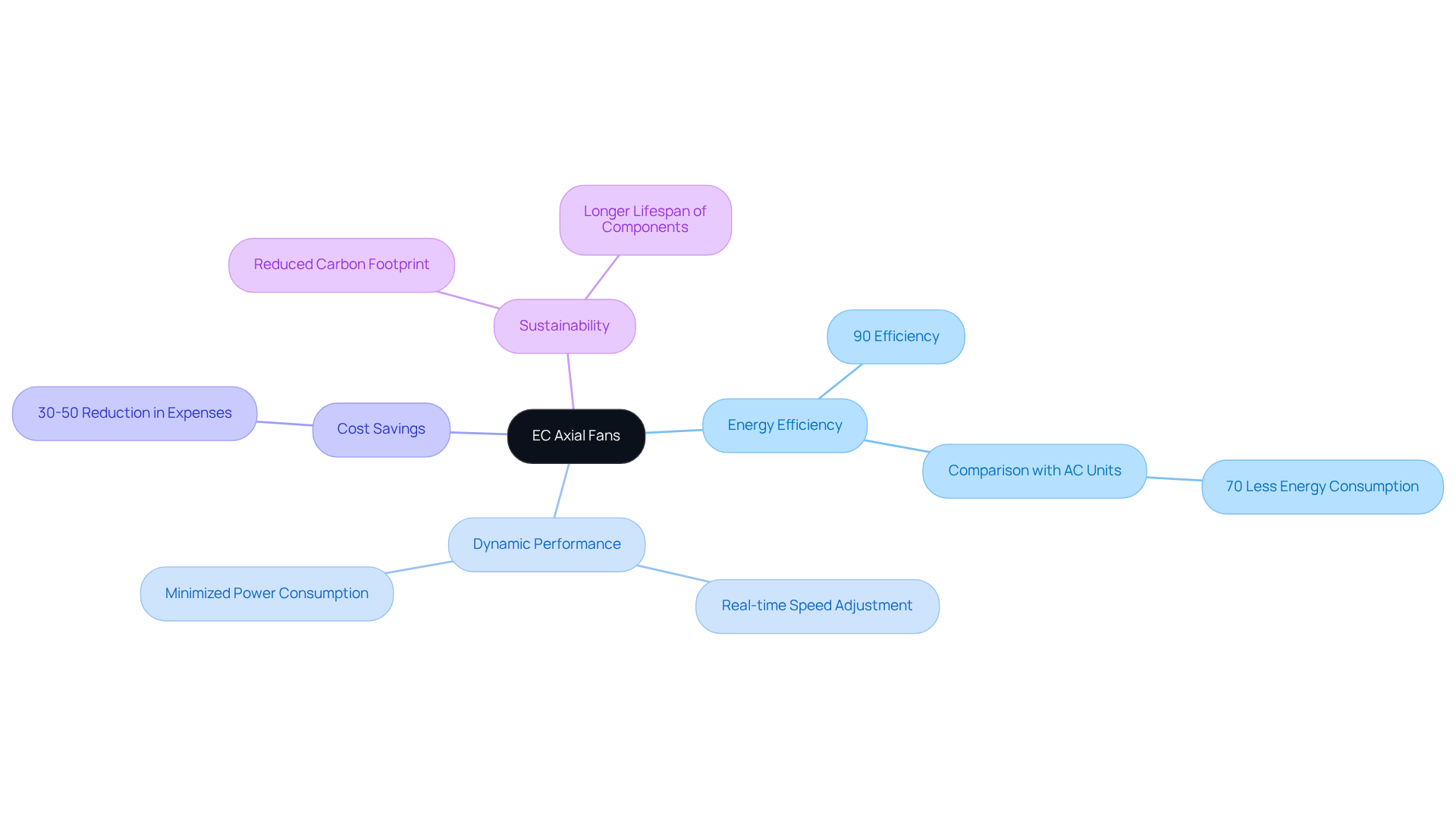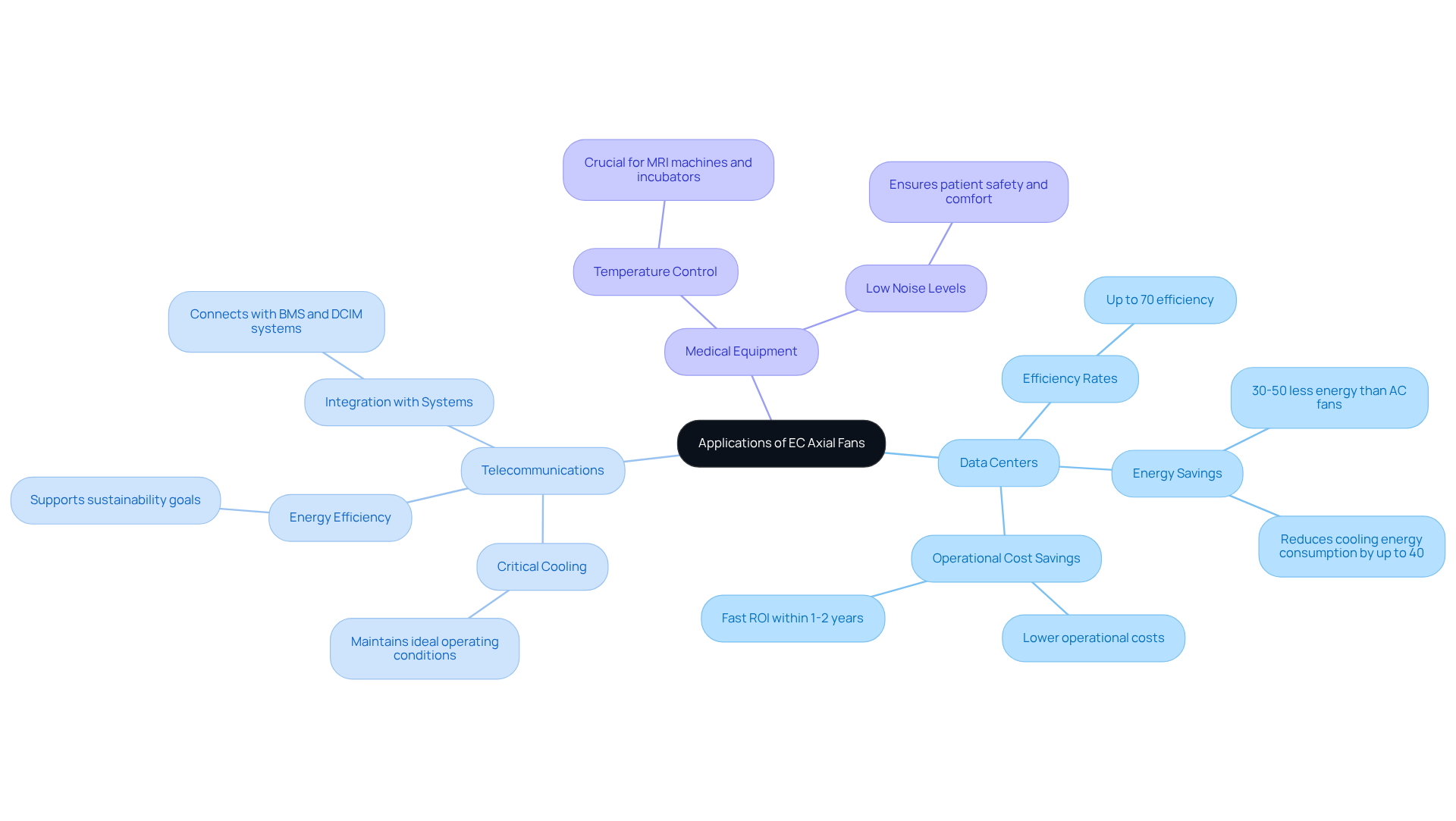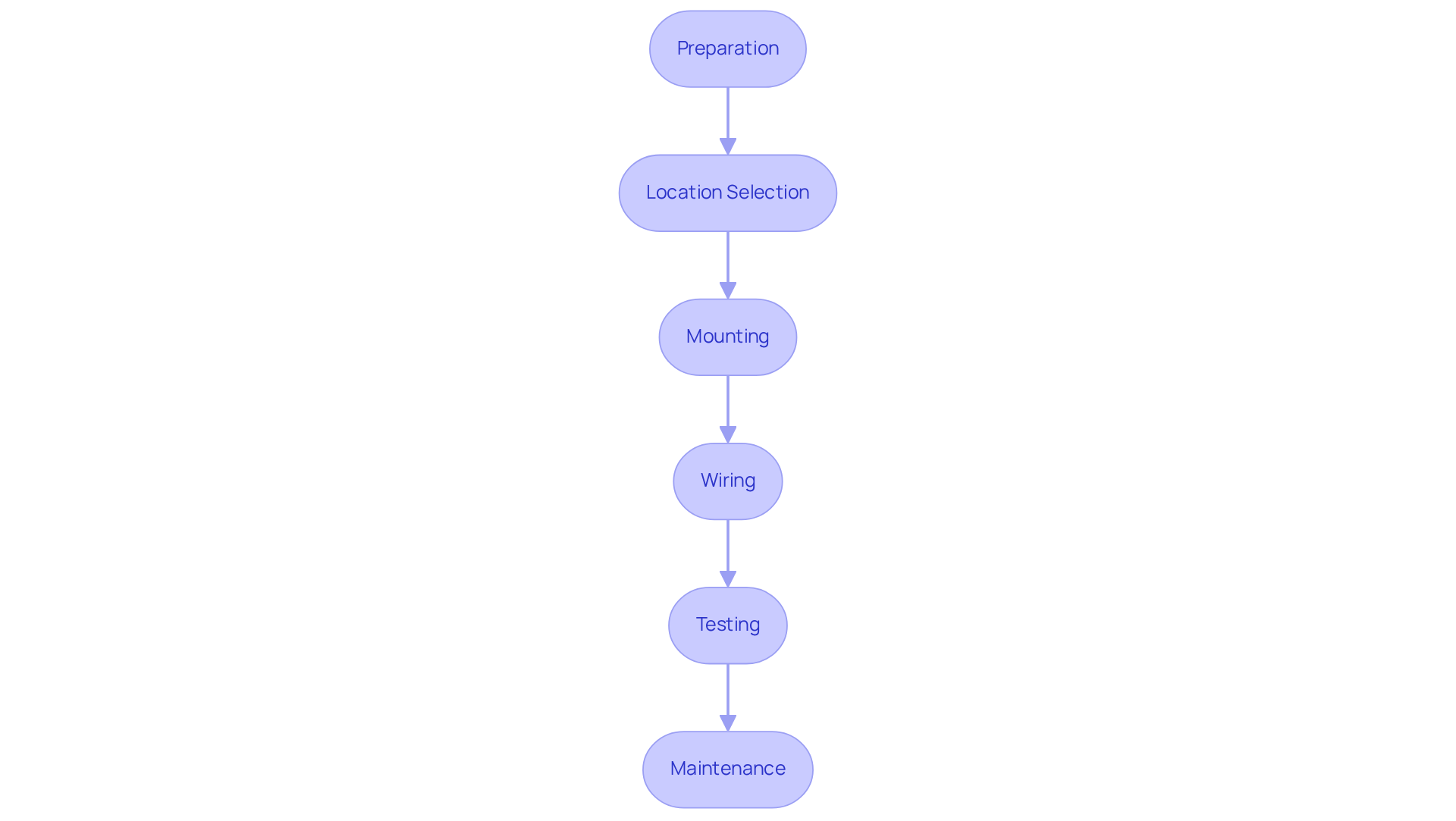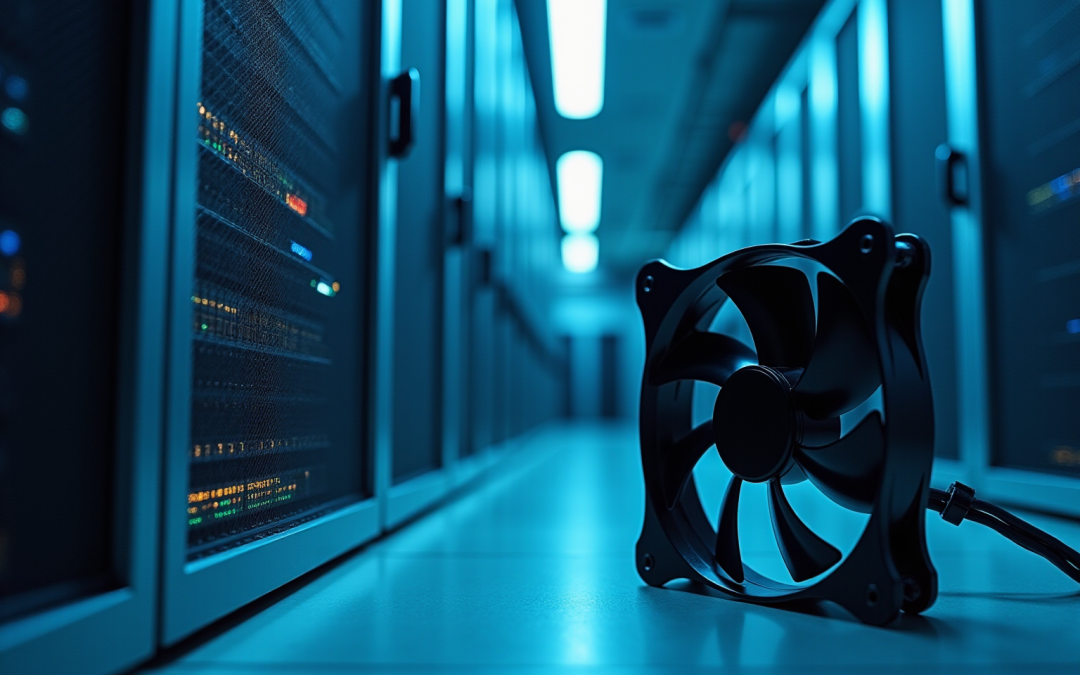Introduction
EC axial fans represent a significant advancement in modern cooling technology, providing a groundbreaking solution for heat management in electronic systems. With energy efficiency ratings reaching up to 90%, these fans not only boost performance but also lead to substantial cost savings in critical environments such as data centers and telecommunications.
However, the shift to EC axial fans prompts essential inquiries:
- How do these sophisticated devices stack up against traditional cooling methods?
- What best practices should be adhered to during installation to fully leverage their advantages?
This article explores the specifications, applications, and vital installation guidelines of EC axial fans, empowering readers with the insights needed to maximize their effectiveness.
Define EC Axial Fans and Their Importance in Electronics
Use english for answers
Revolutionizing Cooling Solutions: The Rise of EC Cooling Devices
In the quest for energy efficiency, traditional cooling methods often fall short. Enter EC axial fans, which are Electronically Commutated blowers that represent a significant leap forward in cooling technology. These advanced solutions utilize brushless DC motors paired with sophisticated electronics, achieving efficiency levels of up to 90%. This remarkable performance far surpasses that of conventional AC units.
Dynamic Performance and Energy Savings
What sets EC units apart is their ability to dynamically adjust speed based on real-time demand. This not only optimizes performance but also minimizes power consumption, making them essential for environments requiring precise cooling and airflow management, such as data centers and telecommunications equipment. Their compact design and quiet operation further enhance their appeal, particularly in noise-sensitive settings.
A compelling case study highlights the substantial energy savings realized by data centers utilizing EC radial blowers. These facilities have reported operational expense reductions ranging from 30% to 50% compared to traditional cooling methods.
The Future of Sustainable Cooling
As the demand for energy-efficient solutions escalates, the importance of EC centrifugal devices in promoting sustainability and efficiency in electronic cooling systems cannot be overstated. By adopting these innovative technologies, organizations can not only reduce their carbon footprint but also achieve significant cost savings.

Explore Technical Specifications and Features of EC Axial Fans
When selecting EC axial fans, it’s essential to consider several key specifications:
- Airflow Rate: This metric, measured in cubic feet per minute (CFM), indicates the volume of air the fan can move. High airflow rates are crucial for cooling high-density electronic components. For instance, server racks typically require 12 to 16 units to enhance air circulation effectively.
- Power Consumption: EC units are engineered to consume significantly less power than conventional AC models, often utilizing up to 50% less electricity. This efficiency leads to substantial operational cost reductions. Studies show that EC devices can save up to $42,000 in energy expenses over an eight-year period.
- Noise Level: Measured in decibels (dB), the noise produced by the fan is critical in applications where quiet operation is necessary, such as in office environments or medical equipment. EC devices are designed to operate silently, frequently maintaining noise levels under 60 dB(A).
- Durability and Lifespan: With fewer moving components and advanced motor technology, EC units typically boast a lifespan of 10 to 15 years, significantly surpassing the 5 to 8 years of conventional AC models. This longevity, coupled with low maintenance requirements, contributes to lower total ownership costs.
- Newest Features: The latest EC units incorporate advanced features such as 0-10V speed control and Modbus compatibility, facilitating seamless integration into contemporary systems and allowing for precise airflow regulation without the need for external inverters. These innovations position EC devices as a superior choice for applications that demand reliable and efficient cooling solutions.
Many EC axial fans come equipped with variable speed control, allowing for precise adjustments based on thermal demands. This capability enhances energy efficiency, enabling devices to operate at lower speeds during off-peak hours, which further reduces energy consumption.

Identify Applications of EC Axial Fans in Electronics Systems
EC axial fans are indispensable in various electronic systems, particularly in telecommunications equipment, where they ensure optimal performance and reliability. Their applications are extensive:
- Data Centers: These fans are essential for regulating temperatures in server racks, preventing overheating that can lead to equipment failure. With EC motors, data centers can achieve efficiency rates of up to 70%, maintaining high airflow while consuming approximately 50% less energy.
- Telecommunications: In telecom cabinets, EC radial blowers provide critical cooling for sensitive equipment, significantly enhancing reliability and efficiency. They maintain ideal operating conditions, which is vital for uninterrupted service. The U.S. Environmental Protection Agency emphasizes that energy-efficient motors, like EC units, support sustainability goals.
- Medical Equipment: These blowers are crucial in devices that require precise temperature control and low noise levels, such as MRI machines and incubators, ensuring patient safety and comfort.
In various manufacturing processes, EC axial fans are vital for maintaining critical cooling, which is essential for equipment efficiency and longevity.
The integration of EC ventilators in telecommunications not only enhances cooling but also aligns with sustainability objectives. They utilize 30-50% less energy than conventional AC units, lowering operational expenses and improving energy efficiency. Additionally, EC units can connect with Building Management Systems (BMS) and Data Center Infrastructure Management (DCIM) systems, further enhancing their efficiency in telecommunications applications.

Guide to Installing and Integrating EC Axial Fans
Integrating EC axial fans into electronic systems demands meticulous attention to several critical steps to guarantee optimal performance and longevity:
- Preparation: Start by confirming that the fan aligns with your system’s specifications. Assess airflow requirements and ensure compatibility with the power supply to prevent operational issues.
- Location Selection: Choose a location that facilitates unobstructed airflow. Avoid positioning the fan near heat sources or in areas prone to dust accumulation, as these factors can significantly impact its operation and lifespan.
- Mounting: Secure the fan using the provided mounting hardware, ensuring it is firmly attached. Proper mounting minimizes vibrations that can lead to noise and potential damage over time. Consider employing vibration-damping mounts to further reduce structural resonance and enhance functionality.
- Wiring: Connect the fan to the power supply according to the manufacturer’s guidelines. Ensure all connections are secure and insulated to avert short circuits, which can jeopardize safety and functionality.
- Testing: After installation, power on the fan and monitor its operation. Evaluate airflow and noise levels to confirm they meet the expected standards. This step is crucial for identifying any immediate issues that may arise.
- Maintenance: Regular inspections are vital for sustaining efficiency. Check for dust accumulation and clean the fan blades and housing as needed. This practice not only boosts performance but also extends the fan’s lifespan, reducing long-term maintenance costs.
By adhering to these best practices, engineers can effectively integrate EC axial fan units into their systems, ensuring reliable operation and energy efficiency. Additionally, recognizing common installation challenges-such as improper alignment or inadequate airflow-can help mitigate potential issues. Solutions include verifying alignment during installation and ensuring that the fan’s specifications correspond with the operational environment, particularly in high-humidity or dusty conditions. Furthermore, incorporating integrated protection features like overcurrent protection and locked rotor detection can significantly enhance the reliability of EC fans during operation.

Conclusion
The significance of EC axial fans in modern electronic systems is paramount. These advanced cooling solutions not only enhance energy efficiency but also align with the sustainability goals of organizations. By harnessing the unique capabilities of Electronically Commutated technology, these fans deliver optimal airflow regulation while minimizing energy consumption, fundamentally transforming cooling strategies across various applications.
Key insights regarding the performance and advantages of EC axial fans have been highlighted throughout this article. Their ability to dynamically adjust speed based on real-time demand, combined with a compact design and quiet operation, makes them particularly well-suited for environments such as data centers and telecommunications. Moreover, the technical specifications underscore their superior energy efficiency, durability, and advanced features that facilitate seamless integration into existing systems.
Ultimately, adopting EC axial fans represents a pivotal step toward achieving both operational excellence and environmental responsibility. Organizations are urged to consider these innovative cooling devices not only for their immediate benefits but also for their long-term impact on energy savings and sustainability. Embracing EC axial fans is not merely a smart choice; it is a commitment to fostering a more efficient and eco-friendly future in electronics.
Frequently Asked Questions
What are EC axial fans?
EC axial fans, or Electronically Commutated axial fans, are advanced cooling devices that utilize brushless DC motors and sophisticated electronics to achieve high efficiency levels, reaching up to 90%.
How do EC axial fans compare to traditional cooling methods?
EC axial fans outperform traditional AC units in terms of energy efficiency and dynamic performance, making them a significant advancement in cooling technology.
What is the advantage of the dynamic performance of EC fans?
EC fans can adjust their speed based on real-time cooling demand, optimizing performance and minimizing power consumption, which is crucial for environments like data centers and telecommunications.
What are some benefits of using EC axial fans in noise-sensitive environments?
Their compact design and quiet operation make EC axial fans particularly suitable for noise-sensitive settings, ensuring effective cooling without excessive noise.
What energy savings have been reported by data centers using EC radial blowers?
Data centers utilizing EC radial blowers have reported operational expense reductions of 30% to 50% compared to traditional cooling methods.
Why are EC cooling devices important for sustainability?
EC cooling devices play a crucial role in promoting sustainability by reducing energy consumption and carbon footprints, while also providing significant cost savings for organizations.

